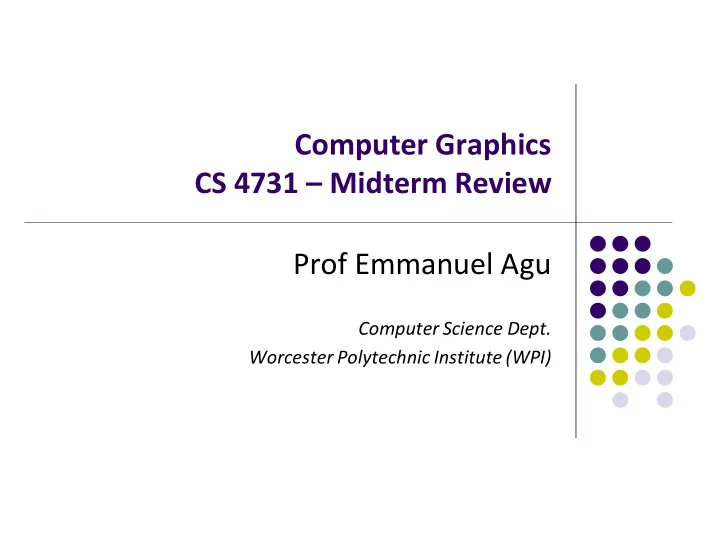

Computer Graphics CS 4731 – Midterm Review Prof Emmanuel Agu Computer Science Dept. Worcester Polytechnic Institute (WPI)
Exam Overview Friday, November 11, 2016, in-class Will cover up to lecture 10 (Rotations) Can bring: One page cheat-sheet, hand-written (not typed) Calculator Will test: Theoretical concepts Mathematics Algorithms Programming OpenGL/GLSL knowledge (program structure and some commands)
What am I Really Testing? Understanding of concepts (NOT only programming) programming (pseudocode/syntax) Test that: you can plug in numbers by hand to check your programs you did the projects you understand what you did in projects
General Advise Read your projects and refresh memory of what you did Read the slides : worst case – if you understand slides, you’re more than 50% prepared Try to predict subtle changes to algorithm.. What ifs?.. Past exams : One sample midterm is on website All lectures have references. Look at refs to focus reading Do all readings I asked you to do on your own
Grading Policy I try to give as much partial credit as possible In time constraints, laying out outline of solution gets you healthy chunk of points Try to write something for each question Many questions will be easy, exponentially harder to score higher in exam
Introduction Motivation for CG Uses of CG (simulation, image processing, movies, viz, etc) Elements of CG (polylines, raster images, filled regions, etc) Device dependent graphics libraries (OpenGL, DirectX, etc)
OpenGL/GLUT High-level: What is OpenGL? What is GLUT? What is GLSL Functionality, how do they work together? Sequential Vs. Event-driven programming OpenGL/GLUT program structure (create window, init, callback registration, etc) GLUT callback functions (registration and response to events)
OpenGL Drawing Vertex Buffer Objects glDrawArrays OpenGL : Drawing primitives: GL_POINTS, GL_LINES, etc (should be conversant with the behaviors of major primitives) Data types Interaction: keyboard, mouse (GLUT_LEFT_BUTTON, etc) OpenGL state GLSL Command format/syntax Vertex and fragments shaders Shader setup, How GLSL works
2D Graphics: Coordinate Systems Screen coordinate system/Viewport World coordinate system/World window Setting Viewport Tiling, aspect ratio
Fractals What are fractals? Self similarity Applications (clouds, grass, terrain etc) Mandelbrot set Complex numbers: s, c, orbits, complex number math Dwell function Assigning colors Mapping mandelbrot to screen Koch curves, gingerbread man, hilbert transforms
Points, Scalars Vectors Vector Operations: Addition, subtraction, scaling Magnitude Normalization Dot product Cross product Finding angle between two vectors Finding normal of plane using cross product, Newell method
Transforms Homogeneous coordinates Vs. Ordinary coordinates 2D/3D affine transforms: rotation, scaling, translation, shearing Should be able to take problem description and build transforms and apply to vertices 2D: rotation (scaling, etc) about arbitrary center: T(Px,Py) R( ) T(-Px,-Py) * P Composing transforms 3D rotation: x-roll, y-roll, z-roll, about arbitrary vector (Euler theorem) if given azimuth, latitude of vector or (x, y, z) of normalized vector Matrix multiplication!!
Building 3D Models Drawing Polygonal meshes
Recommend
More recommend